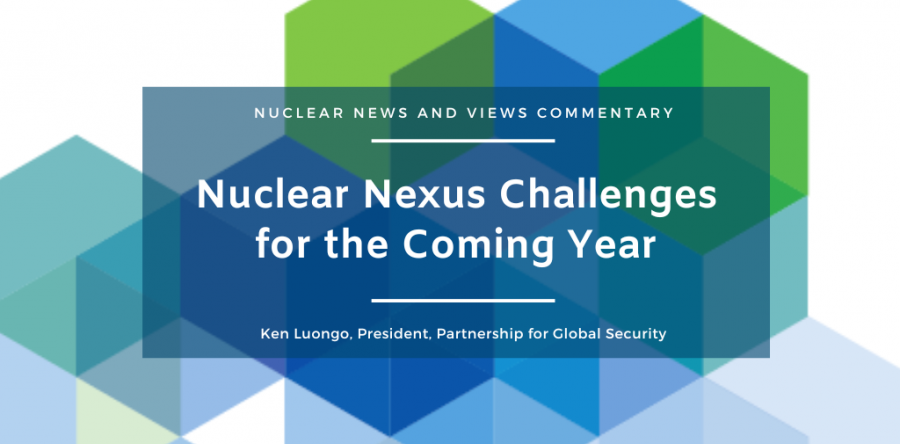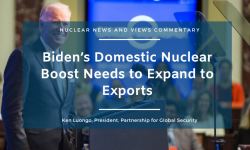The nexus between nuclear energy, climate change, and global security had a breakthrough year in 2022. But to be durable, the Nexus Agenda will require less celebration and more hard work in 2023.
There are three broad areas that will require intensive attention in the coming year – international exports, next-generation market preparation, and technology readiness.
Exports
Nuclear reactor exports have been dominated by Russia in recent years, but the nation’s reputation has been battered by the Ukraine invasion. This has caused nations like Finland to cancel contracts with Russia and other nations, like Poland, to acquire nuclear technology from democratic nations.
Still, Russia’s international business is steady for the time being, with its major state-owned nuclear company, Rosatom, having sold over $10 billion overseas in 2022. Its reactors are under construction in Egypt, Turkey, China, India, Belarus, and Hungary. And it remains a major nuclear fuel provider to U.S. and European reactors.
But the opportunity to replace Russia as the world’s top nuclear provider is now open. The question is whether China or democratic nations will seize it.
China is ambitious, building the largest number of nuclear plants at this time and planning to build 150 more by mid-century. However, China’s international heavy handedness has caused it to be removed as a bidder for large reactors in the U.K., the Czech Republic, and Romania.
French, U.S., and South Korean firms have moved to fill this void. But the intensity of the Western company competition for new nuclear business is limiting needed cooperation and could hand key growth markets to China.
A good example is Saudi Arabia and the Gulf Cooperation Council nations. During a visit to Riyadh in December 2022, China’s President, Xi Jinping, stated that China and the GCC countries should “strengthen new sources of growth such as…[the] peaceful use of nuclear energy.” China’s foreign ministry reported that a “China-GCC forum on the peaceful use of nuclear technology and a China-GCC nuclear security demonstration center will be established” as a result of the visit.
These are soft power steps that should have been taken by Washington and other democratic nuclear nations to prepare the region for Western technology. Korean reactors are already operating in the UAE and are well regarded. But conflict between U.S. and South Korean nuclear companies, as well as Saudi unwillingness to accept more intrusive IAEA monitoring of its nuclear operations, is hobbling their ability to make a reactor bid in the country.
There also is a U.S.-Saudi stand-off over the kingdom’s desire to construct its own uranium enrichment capability. Existing suspicions about its uranium enrichment objectives have been exacerbated by the Saudi foreign minister’s statement that, “if Iran gets an operational nuclear weapon, all bets are off.” That hints that enrichment could be diverted to weapons potential to match Iran.
That is a serious concern. No one wants a nuclear arms race in the Middle East. But that danger is significantly intensified if China controls the Middle East nuclear market by gaining a reactor foothold in Saudi. That development could increase the chance that Saudi Arabia ultimately will possess a uranium enrichment capability that can be used to match Iran’s.
The solution to this situation is not clear and it will require tradeoffs and risk taking. But this is one illustration of the critical, complicated, and challenging export issues that will complicate the Nexus Agenda this year.
Emerging Markets
Beyond the large reactor competition among major vendors, there is the battle for market share in emerging nuclear markets. These are primarily developing economy nations and the focus is on lower-power small modular or advanced technology reactors.
China has a clear advantage under the Belt and Road initiative in the development of energy and infrastructure relationships with many of these markets. And Russia has set its sights on Africa as a prime target. It already has multiple MOU’s in place on the continent.
The U.S. responded at the December 2022 U.S.-Africa Leader’s Summit, and announced the commencement of nuclear cooperation agreement negotiations with Ghana, the signing of a Nuclear Cooperation Memorandum of Understanding with Kenya (a precursor to a formal agreement), and support programs for both countries.
This indicates an intensified tempo of U.S. preparation of new nations for nuclear power. However, the general perception is that this ramp-up is slow, the budget too small, and the effectiveness and scope of the strategy insufficient for the opportunity and timing in the developing world.
The U.S. government and the private sector are pouring billions of dollars into advanced reactor technology development and demonstration. But there is a blind spot on the other issues that will be required to make that investment pay off. This includes intensively cultivating the market for its technologies and developing the new nuclear security guidelines for the next generation of reactors that will allow for secure operation. These are two essential Nexus Agenda issues that need intensified attention this year.
Technology Readiness
The notional timeframe for the deployment of next-generation nuclear energy is roughly 10-15 years, of which about two years have passed already. The Achilles Heel of all nuclear projects traditionally has been cost and schedule. These double dangers have now arisen in relation to smaller reactor deployment.
The leading U.S. SMR technology is NuScale’s VOYGR reactor, which is initially slated to be built in Idaho, is facing cost increases that could impact the continued commitment of its power purchasers in the UAMPS utility consortium. Its deployment schedule has already been delayed once.
For exotic-fueled next-generation advanced reactors, the Congress has mandated that there be a demonstration by 2027. The U.S. government has narrowed the field of reactors that would have to meet this date, but the schedule is very aggressive.
That timetable will be impacted by the availability of the high-assay uranium fuel that these reactors require. At the moment this fuel is not manufactured in the U.S. and the only commercial source for it is Russia.
Complications in the supply of this fuel created by Russia’s invasion of Ukraine has caused Bill Gates’ TerraPower to delay by two years its deployment of the Natrium reactor to replace a coal plant in Wyoming. The U.S. is taking steps to manufacture the fuel domestically, but the lack of available HALEU is going to affect virtually all next-gen reactors that require demonstration by 2027.
These advanced reactors also will be impacted by the development of an appropriate regulatory regime. The Congress mandated that the Nuclear Regulatory Commission adapt its licensing process to the needs of these new reactors. However, it responded with a draft document that landed with a thud and created howls of complaint and the demand for major revisions.
The Nexus Agenda has been elevated by geopolitical, energy, and climate objectives. Russia’s invasion of Ukraine last February rapidly elevated energy security to an international security priority. As a result, nuclear power was revitalized as a key technology to replace reliance on Russian, and other, fossil fuel exports. The role of nuclear energy was prominently featured at the COP 27 climate change conference in Egypt as a zero-carbon energy source.
Now that the nuclear nexus has been embraced with renewed and mainstream enthusiasm, the focus must shift to effectively addressing the issues impacting implementation.
Ken Luongo, President, Partnership for Global Security




